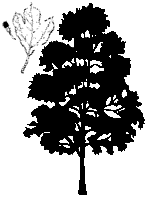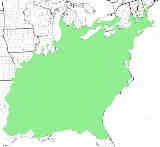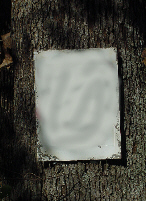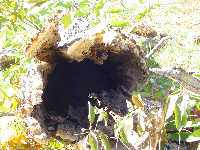


 sassafras
sassafrasSassafras albidum
Sassafras is a small to medium tree with a mature height of 30 to 60 feet and spread of 25 to 40 feet but larger examples exist. This tree is appropriate for most yards, and parks. In nature, the specie usually grows in thickets, but can be developed into single stem shade trees. Grows best on moist, acid, well-drained soil but adaptable to other conditions The leaves are multi-shaped mittens with up to three lobes. Twigs are yellowish green developing into red brown, flat topped, deeply furrowed trunk bark. The fruit is a dark purple drupe that birds relish. Red and orange fall color is common. Monett's South Park has had excellent specimens.
 Plant illustration modified from original by Dale Larison, Missouri Department of Conservation
Plant illustration modified from original by Dale Larison, Missouri Department of Conservation
Range map modified from USDA Forest Service Silvics of North America Web site - www.na.fs.fed.us/spfo/
pubs/silvics_manual/Volume_2/
sassafras/albidum.htm.

|
Trees Are Not Pin Cushions!
Signs are everywhere, along streets, on buildings, in parks, and other locations. None of them belong on trees! Some signs are temporary for a special event like a local festival, others are more permanent such as the hours a park is open, or to not litter. Unfortunately, individuals meaning to help people have damaged the trees that help make a place special. When nails or other fasteners are used to attach a sign to a tree, the trees protective outer layer is broken unnecessarily. When this occurs, the tree is exposed to infection by bacteria, fungi, and insects that can take advantage of the wound. It may appear to be a small wound, but the pests that may attack are smaller and only need small entry points to attack. This may lead to a weakened tree, attack by other pests, decay and / or early death of the tree. Permanent signs present an even greater problem. Trees heal by growing over injuries. A sign, a post, a wire, a nail, or other object that is not pushed away as the tree grows will slowly be encased by the tree as it grows. Sometimes this not a problem, most of the time, the tree is exposed to attack by pests for a long period as the tree tries to encase the object. Later, usually years or decades later, these trees with embedded objects (nails, wire, signs, etc.) die. When it is being removed, the foreign object may be hit by a chainsaw which may cause a deadly kickback occurrence. The saw operators life is endangered needlessly by something that happen years earlier.
Options exist for posting signs, both temporary and permanent. Obviously, a permanent or temporary post could be used. Clamshell design signs can be used temporarily with great effect. Lastly, if a sign is to be temporarily attached to a tree. It should be TIED to the tree, with the sign and attachment material removed as soon as possible to prevent damage.
TRIM Grants at Work in SW Missouri
Tree Resource Improvement and Maintenance (TRIM) grants were awarded to several applicants in SW Missouri. Unfortunately, not all applications were funded. This year $1.4 million in grant requests were made for $500,000 in funding. Applications may be made for anything tree related, but the grant is designed with priority items given preference for funding before items like tree plantings and maintenance pruning. Higher priority items are those that help communities plan for the future like tree inventories, and ordinance creation or revision. Medium category projects include items like hazard tree removal and community employee and public education.
Three projects were awarded funds in my service area. Carthage Parks and Recreation will have an inventory of all trees in maintained areas of the city's parks. This will allow the department to prioritize work, plan for future work and develop city budget requests based on the documented needs.
Neosho Parks and Recreation will provide education to city employees by hiring an ISA Certified Arborist to teach them about proper pruning, planting, tree identification, and other topics. The City will also send two employees to the 2008 Missouri Community Forestry Council Annual Conference in March for additional education.

|
Monett Parks is already removing hazardous trees from South Park. These trees were identified by an ISA Certified Arborist as dangerous to public safety, in part due to the January 2007 ice storm. Some were dangerous prior to that event. The City contracted with a tree care company to drop the trees to the ground. The City is removing the debris, and grinding out the stumps. In conjunction with this project, a local foundation has helped the City to purchase thousands of dollars of trees for planting in both the North and South Parks. Many local groups including Boy Scouts, school clubs, and others have helped plant these new trees.
If you are interested in future TRIM grants, now is the time to start thinking about what you desire to do, and how it fits with the TRIM grant program. Contact me (Jon.Skinner@mdc.mo.gov, 417-629-3423) for information and to start preparing for the application process which begins next mid-spring.